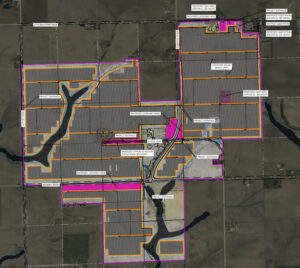
At the end of a five-hour meeting that included input from more than 30 public commenters, the Linn County Board of Supervisors voted 2-1 Monday night to approve the first reading of a rezoning ordinance for a proposed industrial-scale solar project west of Coggon.
Known as Coggon Solar LLC, the $150 million project, proposed by Boise, Idaho-based Clenera Energy, would comprise a 750-acre solar installation on largely agricultural property just west of Coggon in northern Linn County.
The project would generate an estimated 100 megawatts of electrical power and involve installation of just over 300,000 solar panels. Under the plan, submitted to Linn County officials July 9, Clenera would sell generated power to the Central Iowa Power Cooperative (CIPCO) under a 20-year power-purchase agreement, similar to an agreement already in place with a 127-megawatt solar installation near Wapello, also developed by Clenera, which began generating electricity in March 2021.
If installed, the Coggon Solar project would have a total projected production life of about 35 years, according to developers.

The first reading of the proposal, which would rezone the project property from agricultural to agricultural with a special renewable energy overlay, was approved with a pair of conditions introduced at Monday’s meeting – one that would require panels to be mounted a minimum of 28 inches above the ground at their leading edge, and another that would add a 950-foot “soft setback” from the project site for non-participating landowners, in addition to the 300-foot setback already included for all occupied properties near the site.
Supervisors Ben Rogers and Louie Zumbach voted to approve the proposal with the new conditions, while supervisor Stacey Walker voted against the amended plan, indicating he was concerned that Clenera hadn’t been consulted about the changes.
The panel height change is being recommended by Linn County resource conservationist Jon Gallagher, based on possible conflicts with recommended vegetative plantings in the project site. Clenera’s plan would install the lower, leading edge of the solar panels within 18 inches of the ground, but Mr. Gallagher said he felt a 28-inch leading edge panel height would not be “out of line” with solar installations he’d seen elsewhere.
“It’s not my responsibility to be concerned with the fact that certain (vegetative) species might be higher than the leading edge of the array,” Mr. Gallagher said at a Technical Review Committee meeting on the project in November, “That’s a long-term issue that you can ferret out, but that’s why I would suggest raising (the) panel height. From what I’ve seen in other states, the standard is not necessarily 18 inches. And based on (studies) I’ve seen on what it adds to cost, I don’t think 28 inches for a leading edge panel height is out of line. If you’re concerned with the vegetation management plan interfering at an 18-inch leading edge, then you’ll have to develop a plan that addresses that concern.”
He repeated that recommendation at Monday night’s meeting.
Tom Fitzgerald, project development director for Clenera Energy, disagreed with Mr. Gallagher’s assessment at the November meeting. “There is no industry standard in terms of how far off the ground arrays are for this site due to the undulation of some of the terrain,” he said in November. “The technology that we’re using will necessarily have a leading edge that’s 18 inches off the ground. To increase that height by 10 inches across the project would add substantial cost and make it non-economic. I think we can come up with a seed mix to maintain the height of the vegetation to less than 18 inches, but at this time, I don’t think that Clenera is prepared to increase the panel height above that.”
Linn County’s Planning and Zoning Commission voted 6-1 in late November to recommend denial of the rezoning request. Attendees at that meeting mentioned a number of concerns about the proposal, including siting the project on productive agricultural land, taking that land out of production for up to 35 years; the rights of neighboring and adjoining property owners and residents; environmental impacts; potential concerns if a fire were to occur on the site; and responsibility for damage to the property and area from potential high-wind weather events.
Many of those concerns were repeated at Monday night’s meeting, though commenters were nearly evenly split between supporting and opposing the project.
Greg Bickel of Coggon said his property, which includes his home and a koi fish business, would be surrounded on three sides by the project, and noted he was concerned about possible flash flooding from the project site.
“Solar was a good fit for Wapello,” he said. “It’s on flat, poor quality soil and has support from the neighbors. Solar is not a good fit for Coggon … The two major landowners for this project don’t live on their farms. They won’t have to endure a year-long construction or the 30-plus years living next to an industrial complex. However, I will, and 60 of our neighbors will.”
Laura Robinson of rural Coggon, whose family has been embroiled in a lengthy dispute with CIPCO regarding drainage tiles damaged during CIPCO’s most recent upgrades at the Coggon substation, said she hopes supervisors take individual landowners’ concerns into account when making their decision.
“We have to look to the future and preserve the productive farmland for the next generations, for our food supply,” Ms. Robinson said. “Please remember how you vote affects the lives of people. It affects our homes. We are Linn County residents. We’ve been following the rules. Please think of us too.”
A number of project supporters also spoke at the meeting, including a number of local labor leaders who cited an agreement between RES, the project’s general contractor, and the Cedar Rapids/Iowa City Building Trades Council, signed earlier Monday, under which RES promises to utilize local skilled laborers for construction of the Coggon Solar project.
“Coggon Solar is not exploiting our area,” said Junior Luensman of Cedar Rapids, business manager for IBEW Local 405 in Cedar Rapids. “It’s working with and for our community by their commitment to local labor and to utilize a project labor agreement on this project. This project with CIPCO, Clenera and RES Americas is committed to us, the people of Linn County, of Iowa in general and their commitment to local labor groups.”
Two more public hearings are slated to consider the second and third readings of the rezoning ordinance, one Jan. 13, the other Jan. 18. Both will begin at 6 p.m. at the Linn County Fairgrounds in Central City.




